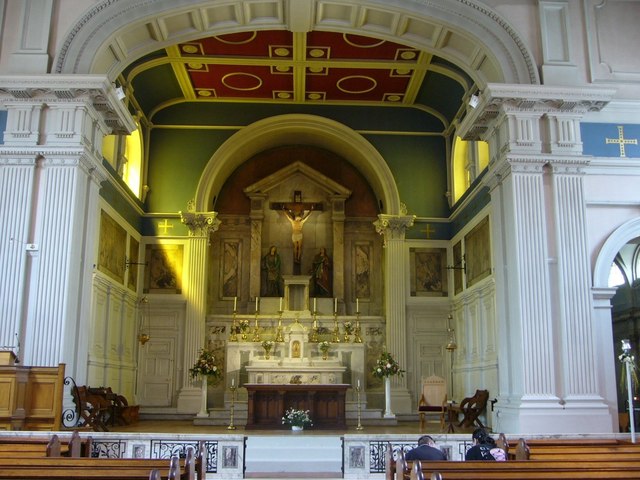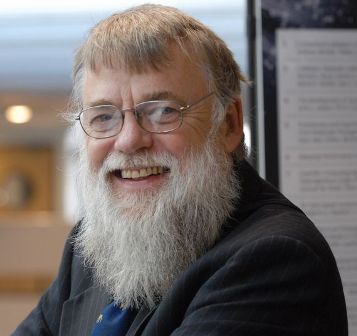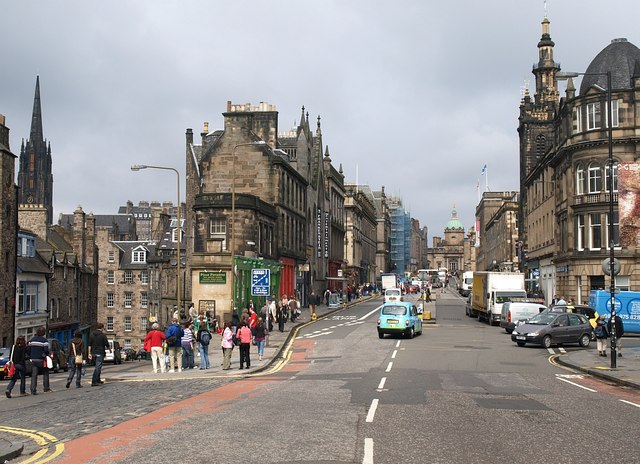|
Cowgate
The Cowgate (Scots language, Scots: The Cougait) is a street in Edinburgh, Scotland, located about southeast of Edinburgh Castle, within the city's World Heritage Site. The street is part of the lower level of Edinburgh's Old Town, Edinburgh, Old Town, which lies below the elevated streets of South Bridge, Edinburgh, South Bridge and George IV Bridge. It meets the Grassmarket at its west end and Holyrood, Edinburgh, Holyrood Road to the east. History Early history The Cowgate developed around 1330 and represented Edinburgh’s first municipal extension. The original settlement on the Cowgate was concentrated on the south side because of a burn on the north, though that was filled in around 1490 and built upon. Archaeological excavations in the 2006 and 2007 found a boundary ditch, dating to the 14th century, near St Patrick's Church, Edinburgh, St Patrick's Church which might have been the full extent of the Cowgate at that time. The street's name is recorded from 1428, ... [...More Info...] [...Related Items...] OR: [Wikipedia] [Google] [Baidu] |
St Patrick's Church, Edinburgh
St Patrick's Church is a Roman Catholic Parish church in the Cowgate part of Old Town, Edinburgh, Scotland. It was built from 1771 to 1774, and became a Catholic church in 1856. The facade of the church was designed by Reginald Fairlie in 1929. It is situated between South Gray's Close and St Mary's Street north of Cowgate and south of the Royal Mile. It is a category B listed building. History Before the Church The first records of the site are property deeds from 1503 to 1531 when it was a waste strip of land. When Archbishop James Beaton built his palace a short distance west of the church in 1509, he also purchased much of this waste. Later Mary Queen of Scots’ Italian servant Francisco de Busso owned part of it. The north part of the church sites was owned, in the late 16th to early 17th centuries, by Dr John Naysmith, surgeon to James VI. The judge Sir James Elphinstone of Logie built ‘Elphinstone Court’ here in the 1670s. The Episcopal Congregation of the Cow ... [...More Info...] [...Related Items...] OR: [Wikipedia] [Google] [Baidu] |
Old Town, Edinburgh
The Old Town ( sco, Auld Toun) is the name popularly given to the oldest part of Scotland's capital city of Edinburgh. The area has preserved much of its medieval street plan and many Reformation-era buildings. Together with the 18th/19th-century New Town, and West End, it forms part of a protected UNESCO World Heritage Site. Royal Mile The "Royal Mile" is a name coined in the early 20th century for the main street of the Old Town which runs on a downwards slope from Edinburgh Castle to Holyrood Palace and the ruined Holyrood Abbey. Narrow '' closes'' (alleyways), often no more than a few feet wide, lead steeply downhill to both north and south of the main spine which runs west to east. Significant buildings in the Old Town include St. Giles' Cathedral, the General Assembly Hall of the Church of Scotland, the National Museum of Scotland, the Old College of the University of Edinburgh and the Scottish Parliament Building. The area contains underground vaults and hidden pass ... [...More Info...] [...Related Items...] OR: [Wikipedia] [Google] [Baidu] |
South Bridge, Edinburgh
South Bridge is a road bridge and street in Edinburgh, Scotland, between the High Street and Chambers Street/Infirmary Street. It extends to North Bridge at the north and Nicolson Street at the south, forming a level roadway over the steep valley scoured parallel to the High Street when the crag and tail landscape was formed. The Cowgate roadway along the bottom of the valley runs under the largest arch of the bridge. The South Bridge Act 1785 was passed in the House of Commons of the United Kingdom on 21 April 1785 and in 1789 taxes were raised to fund the South Bridge to a plan prepared by Robert Adam. The bridge was completed in 1788. It is constructed of nineteen arches, but is almost entirely enclosed by buildings on both sides, exposing only the largest arch where the street crosses the Cowgate. Below deck level are many buildings and vaults, the latter are now something of a tourist attraction. Most of the buildings on the deck level have separate entrances (and some ... [...More Info...] [...Related Items...] OR: [Wikipedia] [Google] [Baidu] |
Gilded Balloon
Gilded Balloon is a producer and promoter of live entertainment events, based in Edinburgh, Scotland, and best known as one of the Big Four venue operators at the Edinburgh Festival Fringe each August. The company has its origins in a venue known as The Gilded Balloon on Edinburgh's Cowgate, where artistic director Karen Koren first started promoting comedy events in 1986. When a fire in 2002 destroyed the original premises, Gilded Balloon shifted its Fringe operations to Teviot Row House in Bristo Square, which became the company's main venue. Gilded Balloon also operates outside the Fringe, running year round events at the Rose Theatre, Edinburgh. History Gilded Balloon founder, Karen Koren, started promoting comedy at McNally's, a restaurant and club based in a townhouse at 6 Palmerston Place, near Haymarket Station, which opened in February 1985. The owner had intended to open a casino upstairs, but it was rejected for a licence. Koren, who was working there alongside oth ... [...More Info...] [...Related Items...] OR: [Wikipedia] [Google] [Baidu] |
Underbelly (venue)
The Underbelly is a venue at the Edinburgh Festival Fringe off Cowgate. From 2001-2004, Underbelly was the only venue operated by Underbelly Limited. In 2005, Underbelly added the Baby Belly venue. In 2006, these venues were joined by the E4 UdderBELLY and the Reid Concert Hall, Cow Barn. History of the Underbelly Underbelly was first opened in 2000, as a small performance venue for five shows brought to the Fringe by Double Edge Drama. The Double Edge directors had heard of the venue through a production of ''Gargantua'', performed by the Scottish company, Grid Iron Theatre Company, Grid Iron in the vaults below the Central Library, Edinburgh, central library of Edinburgh. The site was discovered by Judith Doherty and named 'Underbelly' by Judith and Ben Harrison. Grid Iron staged a show there. The location's and Double Edge's shows won a Fringe First for its critically acclaimed productions of Bent and Marat Sade. In 2001, "Underbelly Limited" and "By Popular Demand Product ... [...More Info...] [...Related Items...] OR: [Wikipedia] [Google] [Baidu] |
Central Library, Edinburgh
Central Library in Edinburgh, Scotland, opened in 1890, was the first public library building in the city. Edinburgh Central library comprises six libraries: Lending, Reference, Music, Art and Design, Edinburgh and Scottish and the Children's Library. History Today there are 28 public libraries in Edinburgh but, as the first to open in the Scottish capital, the creation of Central Library was funded with £50,000 by philanthropist Andrew Carnegie.Central Library City of Edinburgh CouncilEdinburgh Public Libraries 1890–1950, p. 2Armstrong & White, p. 3 At the opening ceremony a telegram from Carnegie was read out stating: "We trust that this Library is to grow in usefullness year after year ... [...More Info...] [...Related Items...] OR: [Wikipedia] [Google] [Baidu] |
Grassmarket
The Grassmarket is a historic market place, street and event space in the Old Town of Edinburgh, Scotland. In relation to the rest of the city it lies in a hollow, well below surrounding ground levels. Location The Grassmarket is located directly below Edinburgh Castle and forms part of one of the main east-west vehicle arteries through the city centre. It adjoins the Cowgatehead/Cowgate and Candlemaker Row at the east end, the West Bow (the lower end of Victoria Street) in the north-east corner, King's Stables Road to the north-west, and the West Port to the west. Leading off from the south-west corner is the Vennel, on the east side of which can still be seen some of the best surviving parts of the Flodden and Telfer town walls. The view to the north, dominated by the castle, has long been a favourite subject of painters and photographers, making it one of the iconic views of the city. History First mentioned in the ''Registrum Magni Sigilii Regum Scotorum'' (1363) as ... [...More Info...] [...Related Items...] OR: [Wikipedia] [Google] [Baidu] |
Thomas Hamilton (architect)
Thomas Hamilton (11 January 1784 – 24 February 1858) was a Scottish architect, based in Edinburgh where he designed many of that city's prominent buildings. Born in Glasgow, his works include: the Burns Monument in Alloway; the Royal High School on the south side of Calton Hill (long considered as a possible home for the Scottish Parliament); the Royal College of Physicians of Edinburgh; the George IV Bridge, which spans the Cowgate; the Dean Orphan Hospital, now the Dean Gallery; the New North Road Free Church, now the Bedlam Theatre; Cumstoun, a private house in Dumfries and Galloway; and the Scottish Political Martyrs' Monument in Old Calton Cemetery, Edinburgh. He was one of the leading Greek Revivalists in Scotland, "more imaginative than his peers and more refined in his detailing". He was a favourite of the church for his Gothic designs, being commissioned to design many Free Churches after the Disruption of 1843. He also designed shops and banks, many of whic ... [...More Info...] [...Related Items...] OR: [Wikipedia] [Google] [Baidu] |
Informatics Forum
The Informatics Forum is a major building on the Central Area campus of the University of Edinburgh. Completed in 2008, it houses the research institutes of the university's School of Informatics. Design The Forum is designed by Bennetts Associates with Reiach and Hall, architects, and Buro Happold, engineers. The architects' brief was to provide a "forum for interaction" that will foster synergies among the 500 researchers in Informatics: Artificial Intelligence, Cognitive Science, Computer Science, and Systems Biology, who have been brought together, under one roof, by this development. The building was the first in Scotland to achieve a BREEAM rating of "excellent", and was constructed by Balfour Beatty. History One of the major recommendations of the 1997 international review that led to the formation of Informatics as an academic grouping at Edinburgh, was that the university should provide a building for the collocation of Informatics. An options appraisal recommend ... [...More Info...] [...Related Items...] OR: [Wikipedia] [Google] [Baidu] |
University Of Edinburgh School Of Informatics
The School of Informatics is an academic unit of the University of Edinburgh, in Scotland, responsible for research, teaching, outreach and commercialisation in informatics. It was created in 1998 from the former Department of Artificial Intelligence, the Centre for Cognitive Science and the Department of Computer Science, along with the Artificial Intelligence Applications Institute (AIAI) and the Human Communication Research Centre. Research in the School of Informatics draws on multiple disciplines. The school is particularly known for research in the areas of artificial intelligence, computational linguistics, systems biology, mathematical logic and theoretical computer science; but also contributes to many other areas of informatics. The School of Informatics was ranked 12th in the world by the QS World University Rankings 2014. As of 2022, the school is ranked 1st in the UK according to ''CSRankings'', 1st in the UK in the latest 2021 Research Excellence Framework (REF) by ... [...More Info...] [...Related Items...] OR: [Wikipedia] [Google] [Baidu] |
George IV Bridge
George IV Bridge is an elevated street in Edinburgh, Scotland, and is home to a number of the city's important public buildings. History A bridge connecting the Royal Mile to the south was first suggested as early as 1817, but was first planned further west and was non-linear and complicated. Plans developed through the 1820s, concluding in 1825 that a linear form aligned with Bank Street (which then connects to The Mound and Princes Street was more logical, even though this required more destruction of existing buildings. This would bridge over the Cowgate and Merchant Street. Measuring in length, the bridge was constructed between 1827 and 1836 as part of the Edinburgh Improvement Act of 1827. Named after King George IV, it was designed by architect Thomas Hamilton (1784–1858) to connect the South Side district of Edinburgh to the Old Town (Royal Mile) and then use exiting streets on the north to connect to the New Town. Two of Edinburgh Old Town's traditional street ... [...More Info...] [...Related Items...] OR: [Wikipedia] [Google] [Baidu] |
Edinburgh Fringe
The Edinburgh Festival Fringe (also referred to as The Fringe, Edinburgh Fringe, or Edinburgh Fringe Festival) is the world's largest arts and media festival, which in 2019 spanned 25 days and featured more than 59,600 performances of 3,841 different shows in 322 venues. Established in 1947 as an alternative to (and on the fringe of) the Edinburgh International Festival, it takes place in Edinburgh every August. The Edinburgh Festival Fringe has become a world-leading celebration of arts and culture, surpassed only by the Olympics and the World Cup in terms of global ticketed events. As an event it "has done more to place Edinburgh in the forefront of world cities than anything else" according to historian and former chairman of the board, Michael Dale. It is an open access (or "unjuried") performing arts festival, meaning there is no selection committee, and anyone may participate, with any type of performance. The official Fringe Programme categorises shows into sections for ... [...More Info...] [...Related Items...] OR: [Wikipedia] [Google] [Baidu] |







